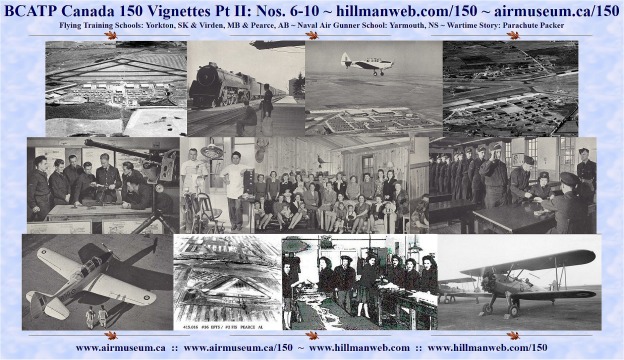009/150:
A World War II Memory
My Wartime Story - Wife and Parachute Packer by Dorine
Brown
The first week of September 1939, I
left my home in Miami Manitoba to enroll in grade 12 at the high school
in Roland. These towns were 12 miles apart so I had to stay there for the
school week.
A few days after school started, Great Britain and Canada
entered the war. Soon most conversations among teachers, students and on
the streets were about the war. There was considerable interest and excitement
about enlisting and one by one the younger generation joined the Forces.
By the end of the war, 260 people from the Roland and Myrtle area had enlisted.
I had become a good friend with one of these young men
by the name of Ivan Brown. He enlisted June 6, 1940 in Winnipeg. His initial
training was at Manning Pool, Brandon. He went from there to St. Thomas,
Ontario for technical training as an aero engine mechanic before being
pcsted to
SFTS (Service Flying Training School) at McLeod, Alta.
The exit of teachers into the Military created a shortage.
Many grade 12 graduates were allowed to become teachers. When a local school
4 miles from Miami was without a teacher in 1940, the school board asked
me to consider the position, and I accepted. The salary was $600 annually.
I had $15/month deducted for the Department of Education to be applied
to Normal School tuition if I were to be a student at a later date. I paid
$15/month for room and board. I went home on weekends, so I was left with
$30. My school had 18 students in grades one to eight. On January 2, 1942
I entered the Hospital in Morden for nursing training. I resigned in July
to prepare for my marriage.
Ivan and I were married at McLeod on August 15, 1942.
Our time together was brief. Ivan was posted overseas in November. Our
first home was a large two-story house with five bedrooms on the second
floor. Five Airforce couples shared this floor. Each room had a rangette,
small table and two chairs, pull-out couch, wooden boxes for dishes etc.
and a clothes closet. I can't remember the bathroom arrangement but I think
we could use the one on the main floor when necessary.
We left by train for a two week embarkation leave to our
homes at Roland and Miami, then to Winnipeg where we were accompanied to
the CPR Station by Ivan's sister Edna, and my sister Marguerite. Ivan left
with hundreds of other military and a number of Service Police keeping
order. I returned home with my sister whom I lived with until March 1945.
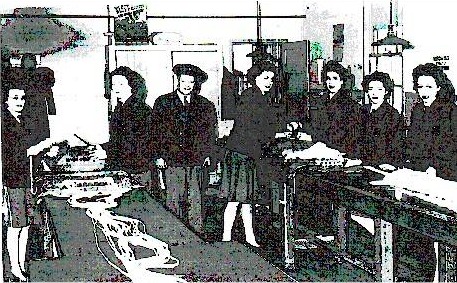 Within
days I went to the employment office. I chose a job of receptionist and
bookkeeper at Peerless Laundry for $50/month. That was heavy work, lifting
bags of laundry over the counter and identifying them. After a month I
returned to the Employment Office and saw the sign "Wanted: Parachute Packer".
I applied and was accepted. It was at #5 AOS (Air Observers School).
It was located in Winnipeg south of the present day International
Airport.
Within
days I went to the employment office. I chose a job of receptionist and
bookkeeper at Peerless Laundry for $50/month. That was heavy work, lifting
bags of laundry over the counter and identifying them. After a month I
returned to the Employment Office and saw the sign "Wanted: Parachute Packer".
I applied and was accepted. It was at #5 AOS (Air Observers School).
It was located in Winnipeg south of the present day International
Airport.
Seven employees including myself worked in this section
of a hanger for $100/month. The parachutes were laid side by side on rows
of shelves. They had to be opened, hung to air in a place we called the
well for three or four days and then repacked. They were made of nylon
, 24 panels, each one numbered and folded by consecutive numbers into a
neat pack. The ropes too were folded in a special way and a card was removed
from the canvas pack, dated, signed and replaced. Sometimes cleaning was
necessary. This was done on a 30 day rotation. The airmen often asked,
"If it doesn't open can I bring it back?"
We worked shifts - either 8a.m. - 4 p.m. or 4 p.m. until
the last flight was in. The last bus left the station in time to catch
the last streetcar that went east on Portage Avenue at 1 a.m.
Since I had taken a St. John's Ambulance course with my
nursing experience, I volunteered at Deer Lodge Hospital. Volunteers wore
a blue smock with a Red Cross on the sleeve. We assisted with bathing,
feeding, back rubs etc. By March, the war in Europe was being terminated
and #5 AOS was closing. The United States was concentrating on the war
in the Pacific Theatre.
Scouts (agents) came from Washington D.C. to the station
to employ experienced people. I accepted a position as a filing clerk and
I left Winnipeg with other girls to begin work April 1. We were in the
Arlington Hotel a short distance from the White House where the British
Admiralty had their offices. I worked for a Lt. Pugsley. He was in charge
of British ships in the Pacific. Reports, orders for repairs etc. for British
ships were received and dispatched from this office. This office closed
for Roosevelt's funeral, the first week of April. The staff walked over
to Pennsylvania Avenue, a distance of two or three blocks to watch the
procession. The humidity in Washington was very high and I remember the
Officers always asking for "a cup of tea".
In August Ivan was on his way home. I had contact with
the Canadian Embassy after I received the following telegram. They informed
me that seven Americans and one Canadian had boarded a certain train. I
was at the station to meet him, it was quite a surprise to my husband.
After a few days we travelled to New York and Niagara
Falls. On August 15 when we were about to celebrate our 3rd anniversary,
news came about victory in Japan. Streets became noisy with people. Business
places closed their doors. The banquet we planned once again had to be
postponed. We walked over the bridge to Niagara Falls N.Y. and joined in
festivities with the Americans in a very noisy environment. There was lots
of free food and drink.
We visited relatives at Durham, Toronto and London, Ontario.
before arriving in Winnipeg September 14.
Ivan received his discharge on October 16th. We remained
in Winnipeg for the winter and bought a farm in Miami in the spring. We
raised our four children on the farm. We retired to Carman in 1988 and
celebrated our 58th anniversary this year August 15, 2000.
~ Dorine Brown
The Commonwealth Air Training Plan Museum has a large number
of wartime reminiscences in the archives.
010/150
No. 36 Elementary Flying Training School ~ Pearce,
Alberta
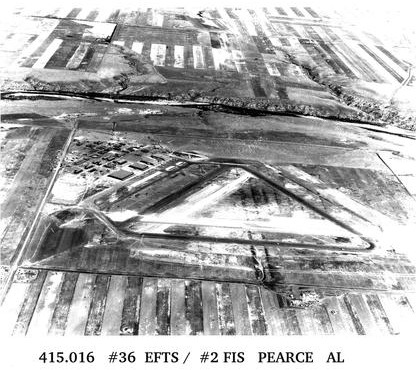 We
found an interesting account of British Commonwealth Air Training Plan
activity in Pearce Alberta on a great website -- www.timothyallanjohnston.com/a-daily-diary-history-of-rcaf-station-pearce-alberta.html.
We
found an interesting account of British Commonwealth Air Training Plan
activity in Pearce Alberta on a great website -- www.timothyallanjohnston.com/a-daily-diary-history-of-rcaf-station-pearce-alberta.html.
It has a selection of excerpts from the daily reports
written for the various schools that were located there during World War
II. It is the story of a BCATP school where no one seemed sure what its
purpose was to be.
Pearce first played host to No. 36 Elementary Flying
Training School which opened on March 30 1942. It was open for 137
days to the Royal Air Force which used de Havilland Tiger Moth and Boeing
Stearman aircraft for flying training. For all Canadian wartime training,
the Stearman was used only by three RAF elementary schools, all located
in Alberta. On May 31 1942, the school had 69 Stearman and 14 Tiger
Moth aircraft.
In anticipation of opening, the school became home for
32 officers and 304 airmen, all RAF, who arrived on March 17 1942. On arrival,
personnel were given the opportunity to exchange a maximum of 10 British
pounds to Canadian dollars. They were also allowed pay advances in the
amount of $50 for officers, $25 for Warrant Officers, $15 for Flight
Sergeants and Sergeants and $10 for Corporals and below. Students did arrive
with the officers and airmen in March and another 90 students arrived from
an overseas voyage to Moncton New Brunswick in early April.
The short-lived station magazine for No. 36 EFTS was "The
Elevator."
There were three fatalities as a result of one mid-air
collision at No. 36 EFTS. After operating for four short months, the school
was relocated on July 14 1942 to another RAF school due to the high winds
at Pearce which students could not cope with in light aircraft.
No. 3 Air Observer School succeeded No. 36 EFTS at
Pearce on September 12 1942. It was open for 267 days. The school,
under the command of the Royal Canadian Air Force, was operated by a private
company known as Prairie Flying Training Ltd. which provided staff pilots
and ground crew for the RCAF. Instruction was provided by RCAF staff. The
first 43 trainees arrived with 12 staff and six officers on September 12
1943 for one Bomb Aimer and two Navigation Courses. By December 31 1942,
the school was home to 14 RCAF staff officers, 2 RCAF WD officers, 2 nursing
sisters, 69 RCAF staff airmen, along with 83 trainees of which 68 were
RCAF, 11 were RAF, 2 were Royal Australian Air Force and 2 were Royal New
Zealand Air Force trainees.
On January 22 1943, a Wings Parade was given to honour
Course 65 which graduated 10 RCAF, 11 RAF, 2 RNZAF and 2 RAAF Air Bomber
grads. There were no wash outs. On April 15 1943 another Wings Parade was
given in honour of the Course 66 Navigators of which 25 were Royal
Australian airmen and 1 was from the RCAF. There was one wash-out.
All of the graduates were posted to No. 1 Y Depot in Halifax Nova Scotia.
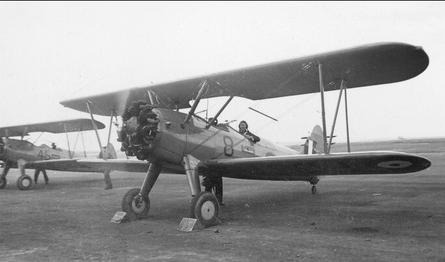
No. 3 AOS was originally located in Regina
Saskatchewan. With the move to Pearce, Regina was reclassified
as No. 3 AOS Detachment. Pearce did not have the facilities that other
Air Observer Schools had and could not accommodate a full complement of
students. As such, Regina continued to train a portion of the classes.
As of December 31 1942, No. 3 AOS in Pearce operated a
total of 19 Avro Anson, 2 Cessna Crane and 1 Stinson aircraft.
Open for less than one year, the writing was on the wall
again for the school in Pearce. On April 3 1943, two courses were
moved to the Regina detachment leaving only one at Pearce. The last course
to graduate at Pearce was in April 1943. By the time No. 3 AOS closed down
in Pearce on June 6 1943, all of its personnel had been dispersed to other
schools and No. 3 AOS Regina Detachment closed when three remaining courses
graduated.
Pearce finished out the war as No. 2 Flying
Instructor School which had been moved from Vulcan Alberta on
April 26 1943. It was in operation for 646 days and closed on January 31
1945.
After closure, Pearce was used until 1960 for the storage
and disposition of aircraft no longer needed by the Royal Canadian
Air Force. It became the final resting place for many aircraft prior to
"breaking-up" and transport to the scrapper.
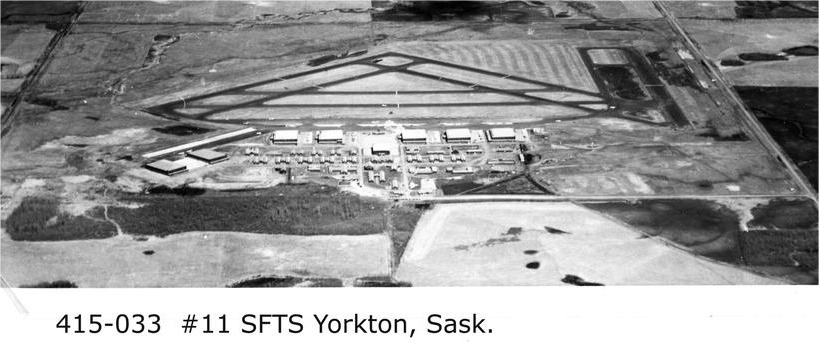
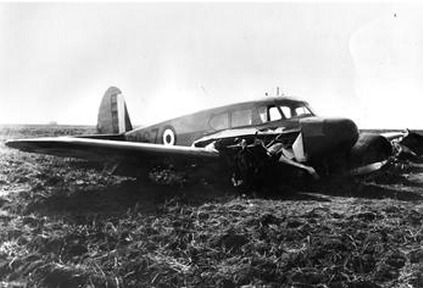
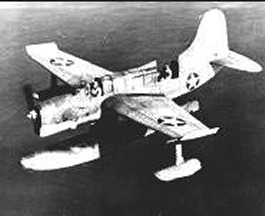 At
No.
1 NAGS, the RCAF was responsible for administration including providing
basic needs like motor transport and medical services. The Royal Navy provided
the training while the Royal Navy and Royal Air Force personnel attached
to the navy provided maintenance for the training wing. Squadron pilots
were recruited from the Royal Navy, Royal Air Force and Royal Canadian
Air Force.
At
No.
1 NAGS, the RCAF was responsible for administration including providing
basic needs like motor transport and medical services. The Royal Navy provided
the training while the Royal Navy and Royal Air Force personnel attached
to the navy provided maintenance for the training wing. Squadron pilots
were recruited from the Royal Navy, Royal Air Force and Royal Canadian
Air Force.
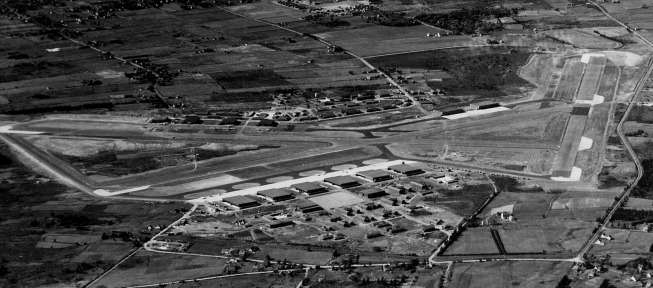
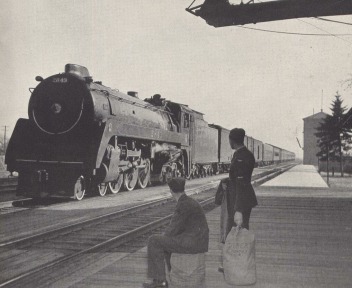 .
.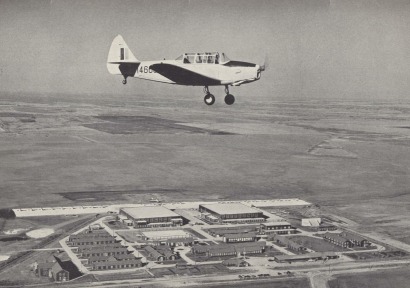 .
.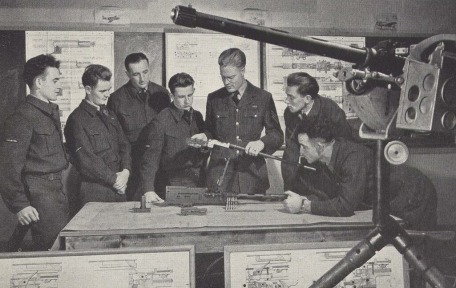 .
.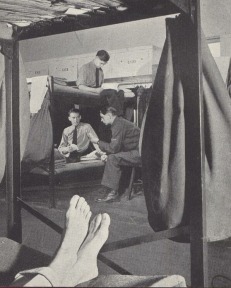 .
.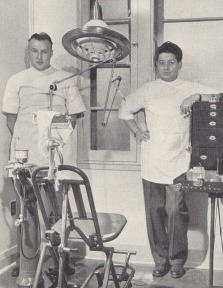 .
.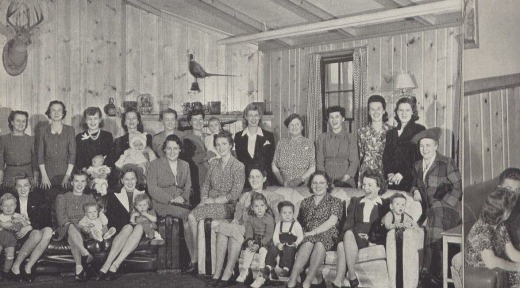 .
.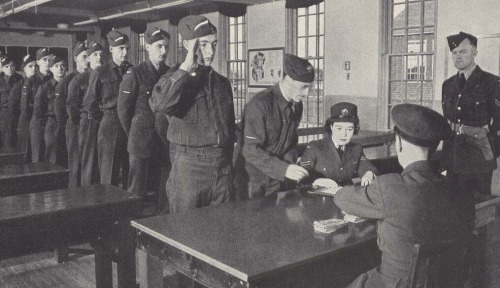 .
.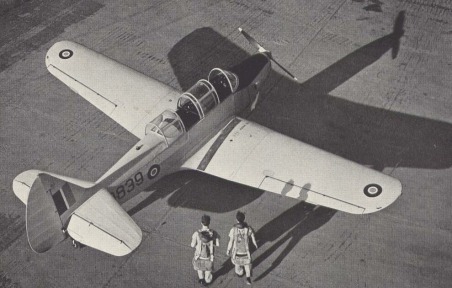
 Within
days I went to the employment office. I chose a job of receptionist and
bookkeeper at Peerless Laundry for $50/month. That was heavy work, lifting
bags of laundry over the counter and identifying them. After a month I
returned to the Employment Office and saw the sign "Wanted: Parachute Packer".
I applied and was accepted. It was at #5 AOS (Air Observers School).
It was located in Winnipeg south of the present day International
Airport.
Within
days I went to the employment office. I chose a job of receptionist and
bookkeeper at Peerless Laundry for $50/month. That was heavy work, lifting
bags of laundry over the counter and identifying them. After a month I
returned to the Employment Office and saw the sign "Wanted: Parachute Packer".
I applied and was accepted. It was at #5 AOS (Air Observers School).
It was located in Winnipeg south of the present day International
Airport.
 We
found an interesting account of British Commonwealth Air Training Plan
activity in Pearce Alberta on a great website -- www.timothyallanjohnston.com/a-daily-diary-history-of-rcaf-station-pearce-alberta.html.
We
found an interesting account of British Commonwealth Air Training Plan
activity in Pearce Alberta on a great website -- www.timothyallanjohnston.com/a-daily-diary-history-of-rcaf-station-pearce-alberta.html.

